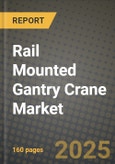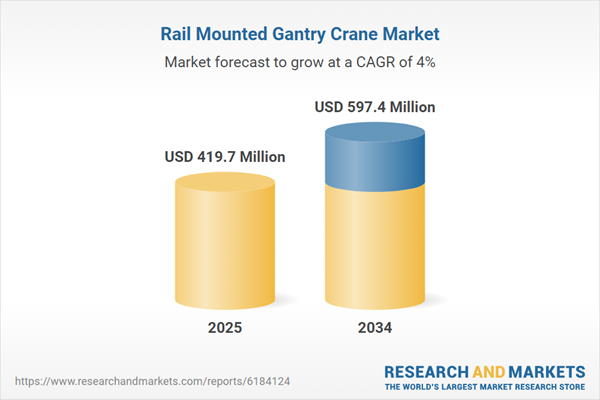Rail Mounted Gantry Crane Market
The Rail Mounted Gantry (RMG) crane market sits at the heart of intermodal logistics, enabling high-throughput container handling across on-dock rail, inland dry ports, and rail-served logistics parks. Unlike rubber-tyred gantries, RMGs deliver precise, repeatable moves over fixed rail corridors, making them ideal for block-train operations, automated stacking yards, and long-span rail terminals. Top end-uses include port rail yards, inland container depots, mega-hubs on freight corridors, and e-commerce-driven regional distribution nodes. Recent trends center on automation (semi- and fully automated RMG/ARMG), digital twins for yard simulation, advanced anti-sway and positioning systems, and electrified drives with regenerative braking and energy-storage add-ons. Key demand drivers include surging intermodal volumes, the push to decongest ports via near-port rail, decarbonization targets that favor electrified handling, land-use optimization (higher stacks and narrower aisles), and workforce safety/availability. The competitive landscape blends global OEMs and specialized European and Asian integrators, with differentiation around automation software, cycle-time efficiency, energy consumption, and lifecycle services. Procurement increasingly follows total-cost-of-ownership logic - factoring availability guarantees, remote diagnostics, condition-based maintenance, and upgrade pathways (automation-ready designs, modular spans). Project risks remain around steel price volatility, grid connection timelines, civil works complexity, and integration with terminal operating systems (TOS), yard management and OCR. Overall, RMGs are gaining share in rail-centric terminal designs, especially where high density, predictable train windows, and emissions objectives demand electrified, automated, and tightly integrated crane-yard ecosystems.Rail Mounted Gantry Crane Market Key Insights
- Automation & ARMG adoption: Terminals are migrating from manual to semi/fully automated RMGs to stabilize productivity and reduce labor exposure. Automation-ready hardware, redundancy in drives, and remote operations rooms are now core specifications rather than add-ons.
- Throughput via yard intelligence: Performance gains come from orchestrating cranes, shuttles, and TOS with real-time optimization. Digital twins test block-train arrival patterns, stacking rules, and crane dispatching to minimize rehandles and dwell times.
- Energy & emissions performance: Full electrification, regenerative braking, and supercapacitor/battery buffers cut energy draw and peak demand. Buyers increasingly request energy dashboards and KPIs tied to sustainability programs and utility incentives.
- Safety & compliance engineered-in: Zoning, geofencing, collision-avoidance lidar, and laser-assisted landing reduce incident risk. Ergonomic cabs, remote condition monitoring, and predictive maintenance improve availability while meeting stricter safety codes.
- Span, stack height & customization: Terminals seek longer spans and higher stacks to compress footprints. Modular girder designs, cantilever options, and automation-grade tolerances tailor cranes to brownfield rail alignments and mixed wagon lengths.
- Integration with TOS & OCR: Native interfaces to TOS, wagon OCR, position-tracking, and RFID ensure accurate inventory and fewer exceptions. Open APIs and cybersecurity-hardened OT networks are becoming contractual must-haves.
- TCO-led procurement & service: Performance-based contracts with availability guarantees shift focus from capex to lifecycle outcomes. Remote diagnostics, digital spares, and CBM strategies reduce unplanned downtime and service truck rolls.
- Financing & delivery models: EPC/EPCM bundles, availability-linked service fees, and phased automation (manual → remote → auto) de-risk deployments. Some buyers adopt lease/operations hybrids to match cash flow with ramp-up volumes.
- Supply chain & lead-time resilience: Steel and component volatility drives multi-sourcing and regional fabrication. Pre-assembly near site, standardized sub-systems, and early grid/civil coordination protect critical path schedules.
- Retrofits vs. newbuild: Brownfield terminals retrofit drives, controls, and positioning systems to extend asset life and step into semi-automation. Newbuild mega-hubs specify end-to-end automation from day one to lock in density and labor savings.
Rail Mounted Gantry Crane Market Reginal Analysis
North America
Growth is anchored in inland ports and on-dock rail as Class I railroads and port authorities target velocity and emissions reduction. Programs prioritize electrification, automation pilots, and Buy-America-aligned sourcing where applicable. Constraints include grid interconnect lead times, winterization requirements, and complex permitting/civil interfaces. Retail e-commerce flows and trans-Pacific volumes keep pressure on intermodal hubs to densify yards, favoring long-span, automation-ready RMGs with strong TOS integration.Europe
RMG adoption benefits from mature intermodal networks, TEN-T corridor investments, and stringent environmental and noise standards. Operators emphasize automation, energy-efficiency guarantees, and compact terminal footprints near urban nodes. Brownfield upgrades dominate in Northwest and Central Europe, while Eastern corridors add new capacity. Local OEMs and integrators compete on precision controls, lifecycle service coverage, and cybersecurity compliance aligned to evolving EU directives.Asia-Pacific
China’s large-scale port-rail and inland hub programs, Japan/Korea automation maturity, and India’s dedicated freight corridors underpin demand. Buyers balance cost sensitivity with automation pathways, often phasing capabilities. Regional fabrication depth shortens lead times, while tropical/climatic conditions drive specs for corrosion protection and heat management. Integration with port TOS and export-heavy flows supports wider spans and higher stacks in gateway and inland nodes.Middle East & Africa
GCC logistics zones, rail expansions linked to mega-ports, and free-zone industrial clusters are key demand pockets. Specifications emphasize high ambient temperatures, dust/sand mitigation, and robust remote diagnostics due to wide site dispersion. In Africa, donor-backed intermodal initiatives and mining-linked corridors favor simpler, durable designs with strong OEM service partnerships and training to sustain availability.South & Central America
Brazil and Mexico lead with corridor modernization, concession-driven yard upgrades, and nearshoring-related flows. Buyers prioritize reliability, energy efficiency, and vendor service presence to mitigate currency and capex cycle risks. Deployment models often bundle civil works and electrification, while phased automation is used to align with workforce strategies and volume ramp-ups across key inland and near-port terminals.Rail Mounted Gantry Crane Market Segmentation
By Lift Capacity
- 0 to 40 Tons
- Above 40 Tons
Key Market players
Konecranes, Liebherr, Sany Group, ZPMC, Kalmar, Doosan Heavy Industries, Mitsubishi Logisnext, Terex Corporation, ABB, Conductix-Wampfler, Cargotec, Weihua Group, GH Cranes, Henan Mine Crane, SpancoRail Mounted Gantry Crane Market Analytics
The report employs rigorous tools, including Porter’s Five Forces, value chain mapping, and scenario-based modelling, to assess supply-demand dynamics. Cross-sector influences from parent, derived, and substitute markets are evaluated to identify risks and opportunities. Trade and pricing analytics provide an up-to-date view of international flows, including leading exporters, importers, and regional price trends.Macroeconomic indicators, policy frameworks such as carbon pricing and energy security strategies, and evolving consumer behaviour are considered in forecasting scenarios. Recent deal flows, partnerships, and technology innovations are incorporated to assess their impact on future market performance.
Rail Mounted Gantry Crane Market Competitive Intelligence
The competitive landscape is mapped through proprietary frameworks, profiling leading companies with details on business models, product portfolios, financial performance, and strategic initiatives. Key developments such as mergers & acquisitions, technology collaborations, investment inflows, and regional expansions are analyzed for their competitive impact. The report also identifies emerging players and innovative startups contributing to market disruption.Regional insights highlight the most promising investment destinations, regulatory landscapes, and evolving partnerships across energy and industrial corridors.
Countries Covered
- North America - Rail Mounted Gantry Crane market data and outlook to 2034
- United States
- Canada
- Mexico
- Europe - Rail Mounted Gantry Crane market data and outlook to 2034
- Germany
- United Kingdom
- France
- Italy
- Spain
- BeNeLux
- Russia
- Sweden
- Asia-Pacific - Rail Mounted Gantry Crane market data and outlook to 2034
- China
- Japan
- India
- South Korea
- Australia
- Indonesia
- Malaysia
- Vietnam
- Middle East and Africa - Rail Mounted Gantry Crane market data and outlook to 2034
- Saudi Arabia
- South Africa
- Iran
- UAE
- Egypt
- South and Central America - Rail Mounted Gantry Crane market data and outlook to 2034
- Brazil
- Argentina
- Chile
- Peru
Research Methodology
This study combines primary inputs from industry experts across the Rail Mounted Gantry Crane value chain with secondary data from associations, government publications, trade databases, and company disclosures. Proprietary modeling techniques, including data triangulation, statistical correlation, and scenario planning, are applied to deliver reliable market sizing and forecasting.Key Questions Addressed
- What is the current and forecast market size of the Rail Mounted Gantry Crane industry at global, regional, and country levels?
- Which types, applications, and technologies present the highest growth potential?
- How are supply chains adapting to geopolitical and economic shocks?
- What role do policy frameworks, trade flows, and sustainability targets play in shaping demand?
- Who are the leading players, and how are their strategies evolving in the face of global uncertainty?
- Which regional “hotspots” and customer segments will outpace the market, and what go-to-market and partnership models best support entry and expansion?
- Where are the most investable opportunities - across technology roadmaps, sustainability-linked innovation, and M&A - and what is the best segment to invest over the next 3-5 years?
Your Key Takeaways from the Rail Mounted Gantry Crane Market Report
- Global Rail Mounted Gantry Crane market size and growth projections (CAGR), 2024-2034
- Impact of Russia-Ukraine, Israel-Palestine, and Hamas conflicts on Rail Mounted Gantry Crane trade, costs, and supply chains
- Rail Mounted Gantry Crane market size, share, and outlook across 5 regions and 27 countries, 2023-2034
- Rail Mounted Gantry Crane market size, CAGR, and market share of key products, applications, and end-user verticals, 2023-2034
- Short- and long-term Rail Mounted Gantry Crane market trends, drivers, restraints, and opportunities
- Porter’s Five Forces analysis, technological developments, and Rail Mounted Gantry Crane supply chain analysis
- Rail Mounted Gantry Crane trade analysis, Rail Mounted Gantry Crane market price analysis, and Rail Mounted Gantry Crane supply/demand dynamics
- Profiles of 5 leading companies - overview, key strategies, financials, and products
- Latest Rail Mounted Gantry Crane market news and developments
Additional Support
With the purchase of this report, you will receive:- An updated PDF report and an MS Excel data workbook containing all market tables and figures for easy analysis.
- 7-day post-sale analyst support for clarifications and in-scope supplementary data, ensuring the deliverable aligns precisely with your requirements.
- Complimentary report update to incorporate the latest available data and the impact of recent market developments.
This product will be delivered within 1-3 business days.
Table of Contents
Companies Mentioned
- Konecranes
- Liebherr
- Sany Group
- ZPMC
- Kalmar
- Doosan Heavy Industries
- Mitsubishi Logisnext
- Terex Corporation
- ABB
- Conductix-Wampfler
- Cargotec
- Weihua Group
- GH Cranes
- Henan Mine Crane
- Spanco
Table Information
| Report Attribute | Details |
|---|---|
| No. of Pages | 160 |
| Published | November 2025 |
| Forecast Period | 2025 - 2034 |
| Estimated Market Value ( USD | $ 419.7 Million |
| Forecasted Market Value ( USD | $ 597.4 Million |
| Compound Annual Growth Rate | 4.0% |
| Regions Covered | Global |
| No. of Companies Mentioned | 15 |









